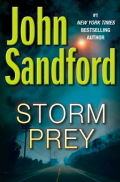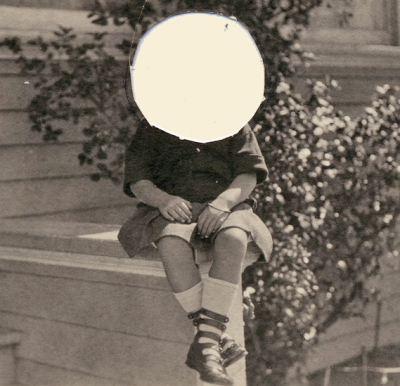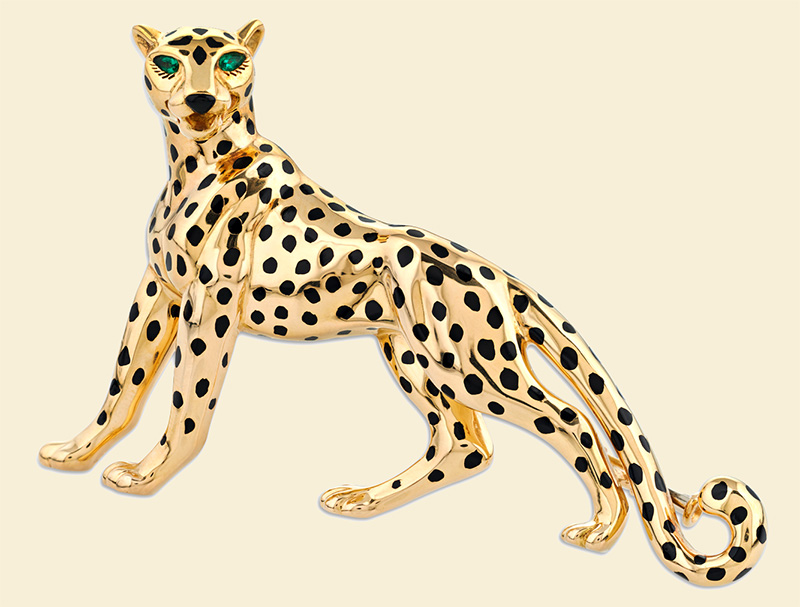This panther brooch (brooch, n., an ornament fastened to clothing with a hinged pin and catch) by Cartier is for sale at M.S. Rau Antiques for $38,500, coincidentally just about exactly the median household annual income in the village nearest where I live.
• The great British author Virginia Woolf was a photographer—here's an article featuring her snapshots of the Bloomsbury Group.
 • The most popular book by our friend John Camp a.k.a. John Sandford is Storm Prey (2010) according to Goodreads. It's #20 in the Lucas Davenport Series. I just met a local guy who could hardly believe I know John—he fixed me with an intent stare and said, "he's one of my guys. I read ev-er-y-thing he writes."
• The most popular book by our friend John Camp a.k.a. John Sandford is Storm Prey (2010) according to Goodreads. It's #20 in the Lucas Davenport Series. I just met a local guy who could hardly believe I know John—he fixed me with an intent stare and said, "he's one of my guys. I read ev-er-y-thing he writes."
• Canon has introduced a new mirrorless camera. The new M50 has a 24-MP sensor, an electronic viewfinder, and is the first camera in the Canon's M series to include 4K video. It costs $899 with its compact 15–45mm kit lens and is available in white. It is said to be targeted to beginners.
• This is a snapshot no lover of photography (well, none who knows who these guys are, anyway) will fail to appreciate—William Klein and Daido Moriyama snapping pictures of each other at Akio Nagasawa Gallery in Tokyo, on Instagram.
• If you ever in a past life enjoyed smoking those funny marryjehoochie cigarettes, Master KK's latest "Up the Box" (NSFW, n.b.) will make you laugh and groovealong. Includes some super-rare tracks. You might enjoy it even if you are not, um, high. (And please, I know I've opened the door, but let's not discuss illegal substances in the squeaky-clean TOP Comments section. Thenk-yew, the Ed.)
• Yesterday saw the introduction of the Sony A7III, the third iteration of the basic level of the highly popular A7 series. B&H Explora has posted the launch. Sony typically does not stint in letting its best technologies trickle down, and the A7III loads into the sub-$2k (barely) basic A7 camera many of the advances of the A9 and A7RIII. It is not yet available for pre-order.
 Provenance unknown, from a show called Gathered: Snapshots from the Peter J. Cohen Gift and Works by Carmen Winant and Luke Stettner, an exhibition from late 2016 that celebrated the gift of more than 200 amateur photographs from the collection of Peter J. Cohen to the Columbus (Ohio) Museum of Art. Although the body had its identity elided, doubtless the missing head was clipped out in order to be treasured in a locket or honored in miniature frame, so no need to mourn the headlessness of the anonymous subject.
Provenance unknown, from a show called Gathered: Snapshots from the Peter J. Cohen Gift and Works by Carmen Winant and Luke Stettner, an exhibition from late 2016 that celebrated the gift of more than 200 amateur photographs from the collection of Peter J. Cohen to the Columbus (Ohio) Museum of Art. Although the body had its identity elided, doubtless the missing head was clipped out in order to be treasured in a locket or honored in miniature frame, so no need to mourn the headlessness of the anonymous subject.
• Speaking of detachable heads, Frankenstein by Mary Shelley, one of the most remarkable masterpieces in Western literature, is celebrating (if that's the right word) its bicentennial this year. It was published on January 1, 1818. (The link is to the 1818 first edition text.) The book and myth is incredibly rich; it resonates with meanings that range from from slavery, to feminism, to the usurpation of God, to the heartlessness of science, to the emotion of revenge, to the experience of crushing loss and the longing for the dead to rise—Mary Shelley in her life was devastated by the loss of successive children, and she outlived most of her illustrious parents and her even more illustrious circle of friends that included her husband the poet Percy Bysshe Shelley and Lord Byron.
• The China Institute at 100 Washington Street in Manhattan will for most of this year be showing Art of the Mountain: Through the Chinese Photographer's Lens:
Art of the Mountain will consist of three sections: Revered Mountains of China will introduce the geography, history, legends, and culture that are associated with Chinese mountains and will include photographs by Hou Heliang, Kang Songbai and Kang Liang, Li Daguang, Lin Maozhao, Li Xueliang, Lu Hao, Zhang Anlu, Xiao Chao, Yan Shi, Wang Jing, Zhang Jiaxuan, Zhang Huajie, and Zheng Congli. Landscape Aesthetics in Photography will present Wang Wusheng’s photography of Mount Huangshan, also known as Yellow Mountain, to reflect the renowned Chinese landscape painting aesthetic and its influence. New Landscape Photography includes the works of Hong Lei, Lin Ran, Lu Yanpeng, Shao Wenhuan, Taca Sui, Xiao Xuan’an, Yan Changjiang, Yang Yongliang, Yao Lu, Zeng Han, Gao Hui, and Feng Yan, who express their thoughts on the role of mountains in society.
Mike
(Thanks to Ned Bunnell)
Original contents copyright 2018 by Michael C. Johnston and/or the bylined author. All Rights Reserved. Links in this post may be to our affiliates; sales through affiliate links may benefit this site.
B&H Photo • Amazon US • Amazon UK
Amazon Germany • Amazon Canada • Adorama
(To see all the comments, click on the "Comments" link below.)
Featured Comments from:
Steve Rosenblum: "I first read "Frankenstein" as part of an undergraduate literature course on science fiction taught by Prof. Eric Rabkin at the University of Michigan in 1971 or 1972. It was a rigorous, wonderful course and I think that Eric may still be teaching it. "Frankenstein" was the first reading for the course. I had low expectations of it, and was totally entrhalled by what a wonderful book it is, as well as the amazing story of Mary Shelley, its writing, and the interlocking lives of Mary, Lord Byron, and her husband the poet Shelley. It is nothing like the movie made in the 1930's. Speaking of movies, I also highly recommend "Young Frankenstein" to anyone who hasn't seen it. IMHO the funniest movie ever made."
John Camp: "And Mary Shelley's circle also included John Polidori, Byron's personal physician. She, Percy Shelley, Byron and Polidori one night agreed to write 'ghost stories.' Hers eventually evolved into Frankenstein. Polidori's, published a year after Frankenstein, was called 'The Vampyre,' and is generally acknowledged to be the first vampire story and the model for the character Dracula (the Dracula story itself was written 70 or 80 years later by another guy.) The stories by the two famous writers didn't amount to much."
Geoff Wittig: "The 'Art of the Mountain' show sounds fabulous. While my ignorance of Chinese art and photography are profound, my understanding is that photographs and especially paintings of the iconic Yellow Mountain region of China are perhaps analogues to heroic 'Western' art in American culture. To my eye, archetypal Western landscape paintings by Bierstadt and Moran are very similar in their heroic motif to Ansel Adams' equally dramatic photographs. Traditional Chinese painting by contrast tends to be more gestural, suggestive and subtle. So too are the Chinese mountain photographs I'm familiar with. Wang Wusheng's lovely 2005 photo book Celestial Realm: The Yellow Mountains of China is full of delicate, moody fog-draped images. And it's still available new. Just sayin'.
"On an unrelated matter, is it just me, or is Canon's M50 the ugliest mirrorless camera we've seen yet? Fujifilm's X-T2 is a lovely piece of photo jewelry; Panasonic and Olympus mirrorless cameras look purposeful. But Canon's M50 and M5 are photo-Edsels. Lumpy, inelegant and dull. Maybe it works great, but it's so homely I'd be embarrassed to pull it out to take a shot. 'Course, it could just be me."
cdembrey (partial comment): "For me the most interesting recent announcement was Canon's new flash. From my POV, seen one camera and you've seen them all—YMMV."
Ken Tanaka: "I was delighted to see one of Peter Cohen’s found photos in this story! A good friend of mine, Peter has amassed one of the largest and richest collections of anonymous and found photographs anywhere. That’s how he enjoys photography. And it turns out he’s not alone, as there’s a very lively community of similar collectors out there. In recent years Peter has opened his collection to museum curators (The Met, The Art Institute of Chicago, The Columbus Museum of Art, et al) who have created some very unique and memorable shows from the collection. In 2011, for example, Michal Raz-Russo here at the Art Institute of Chicago created a show titled 'The Three Graces' after she and Peter noticed that so many of the snaps contained three women. In 2015, Mia Fineman, an associate curator at The Met, published a cute book titled Snapshots of Dangerous Women with images also mined from Peter’s collection.
"Yet another example of how photography and photographs can be enjoyed and used toward creative objectives...without using a camera."




I think the Canon M 50 is an interesting camera.
It is less an experienced enthusiast’s camera than an invitation to go beyond the smart phone . Making it easier to begin to ‘get serious’ about photography and video. It costs less than an iPhone X.
Introduced simultaneously was a flash that uses AI to find the best bounce angle-automatically.
Again not an enthusiast tool but one directed at getting people more pleasing pictures.
I don’t know if either strategy will work but I think it speaks well for Canon’s efforts to engage photography’s next generation.
I hope it works.
It also tells me that their efforts in AI won’t be limited to flashes.
All in all , it seems forward looking to me, rather than just ‘playing defense’
Posted by: Michael Perini | Tuesday, 27 February 2018 at 11:54 AM
Now is the time for you to buy a used (or new and severely price cut in the near future) Sony A7II.
Posted by: Paulo Bizarro | Tuesday, 27 February 2018 at 12:14 PM
Every time a new A7 arrives I check to see if they've included a 5:4 or 4:3 crop mode. Every time I sigh in disappointment and my credit card sighs with relief.
Also, Sigma's announcement of nine Art lenses native to the E-mount didn't make my sigh of disappointment any shallower.
Posted by: Kalli | Tuesday, 27 February 2018 at 12:25 PM
Hi Mike,
Happy belated birthday!
It looks like your link to Klein and Murayama is not correct. I tried both Chrome and Firefox. Looking forward to seeing that one.
--mike
[Sorry. Fixed now. --Mike]
Posted by: mike rosenlof | Tuesday, 27 February 2018 at 12:57 PM
Speaking of Frankenstein, today's New York Times has a feature on internet dating profiles for various movie characters, including Young Frankenstein:
https://www.nytimes.com/2018/02/22/movies/shape-of-water-monster-dating-profiles.html?rref=collection%2Fsectioncollection%2Fmovies&action=click&contentCollection=movies®ion=rank&module=package&version=highlights&contentPlacement=2&pgtype=sectionfront
Posted by: Gordon Brown | Tuesday, 27 February 2018 at 02:47 PM
If you are interested in that group of romantic poets, Tim Powers has an alternate history novel that weaves them with a type of vampire/muse:
https://en.wikipedia.org/wiki/The_Stress_of_Her_Regard
Posted by: KeithB | Tuesday, 27 February 2018 at 02:59 PM
“The great
BritishEnglish author Virginia Woolf”, fixed that for you ;-) Even Wikipedia gets that right.Posted by: Richard Parkin | Tuesday, 27 February 2018 at 03:01 PM
Sorry to break your prohibition on mentioning illegal substances in your comments section but I do wonder if a post from you about pictures under the influence might not in fact be worth considering?
Posted by: Patrick Dodds | Tuesday, 27 February 2018 at 03:50 PM
If you want to read Frankenstein this year read the original 1818 text.
Shelley reissued the book when the stage plays of it took off (introducing all the things "we know" about Frankenstein that reappeared in the 1930s movies) but that text is edited.
You can find the 1818 text at Gutenberg.org (epub too). Or Penguin Classics has the 1818 text in paper form.
http://www.gutenberg.org/ebooks/41445
You might also want to take a look at Frankenstein: The First Two Hundred Years by Christopher Frayling to put everything Frankenstein in a broad cultural context.
https://www.amazon.com/Frankenstein-First-Two-Hundred-Years/dp/1909526460
Or if you only have an hour to spare you can get the radio version of the Frayling book (from a BBC Radio 4 Archive on 4 programme presented by Christopher Frayling) to discover the cultural history of the book. Strongly recommended.
http://www.bbc.co.uk/programmes/b09lvy6l
Did you know the original Monster was not a shambling, groaning idiot but erudite and prone to quote Milton's Paradise Lost? You should listen to the show.
"Walk this way ..."
Posted by: Kevin Purcell | Tuesday, 27 February 2018 at 04:32 PM
There is also, "Dreams of the Golden Mountain", by the photographer Pok Chi Lau.
Posted by: Herman Krieger | Tuesday, 27 February 2018 at 05:13 PM
An interesting diversion, like the sleight of a magicians hands, while we look for a bakers dozen....
;-)
Posted by: Mark Kinsman | Tuesday, 27 February 2018 at 05:24 PM
I once went to the Yellow Mountain. It is very frequently foggy there. The views are splendid and there's no shortage of tourists. In addition to landscape photographers, Martin Parr could offer an interesting take on it.
Posted by: Oskar Ojala | Tuesday, 27 February 2018 at 06:40 PM
Keith B beat me to it...Stress of Her Regard is a romp!
Posted by: SteveW | Tuesday, 27 February 2018 at 07:50 PM
Re the Woolf photo album, scroll down the article about half way and you discover (possibly to your horror...) that she seems to have been an early cat photographer.
Dave.
Posted by: David Elden | Tuesday, 27 February 2018 at 08:32 PM
Global median per-capita income is estimated to be about 2,500. And here we are discussion the purchase of light capturing gizmos that cost about that much.
Posted by: Hiawatha Jones | Tuesday, 27 February 2018 at 09:44 PM
I don't know about the black version, but that white M50 is pretty awful looking.
Posted by: Stephen Gilbert | Tuesday, 27 February 2018 at 10:25 PM
I happened to read Micheal Perini's comment after reading this article, "The Sublime and Scary Future of Cameras With A.I. Brains," in the New York Times about the use of artificial intelligence in a Google camera called Clips: https://www.nytimes.com/2018/02/27/technology/future-cameras-ai-brains.html. I think using this one line from the article would be ok under the Fair Use doctrine: "It uses so-called machine learning to automatically take snapshots of people, pets and other things it finds interesting." In other words, the camera decides what is interesting and shoots a short video clip.
Posted by: Ken | Tuesday, 27 February 2018 at 11:01 PM
Geoff Wittig: It's not just you. Early Hyundai.
Posted by: Gary | Wednesday, 28 February 2018 at 12:29 AM
Or the Isetta.
https://en.wikipedia.org/wiki/Isetta
Posted by: Gary | Wednesday, 28 February 2018 at 12:33 AM
Maybe not the reason you posted it, but that Cartier brooch is absolutely stunning.
Posted by: Rick Denney | Wednesday, 28 February 2018 at 08:42 AM
To add to the comments about Byron, Percy and Mary Shelley, it is suggested that the reason they were cloistered together for a prolonged period with little to do but write, was that Tambora had erupted the previous year, reducing Global temperatures and causing the incessant rain they endured. In addition to their writing it may have influenced the development of Mormonism and migration to the Ohio valley. A much more complete and erudite analysis is here: https://www.economist.com/news/briefing/21647958-two-hundred-years-ago-most-powerful-eruption-modern-history-made-itself-felt-around
Posted by: Stuart | Wednesday, 28 February 2018 at 07:27 PM